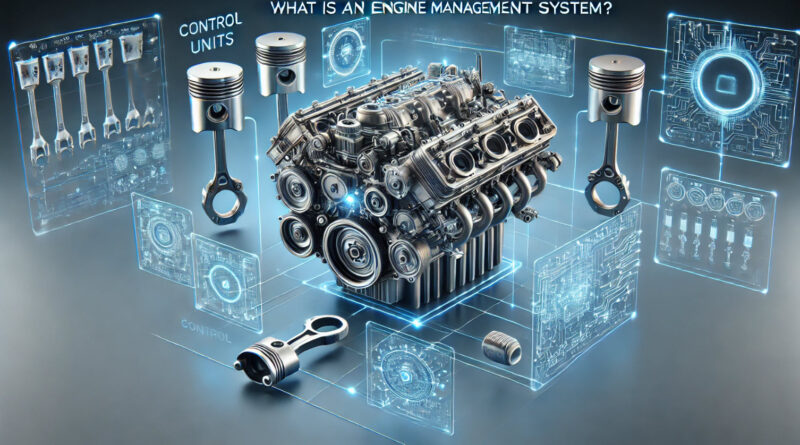What Is an Engine Management System? A Simple Guide
Here’s what Is an engine management system what it does, how it works, and why it matters. If you’ve ever wondered how your car’s engine runs so smoothly, delivers power when you need it, and doesn’t guzzle fuel, the answer lies in its Engine Management System (EMS). Think of the EMS as the brain of your car’s engine. It constantly monitors what’s happening under the hood and makes adjustments to keep everything running just right. From balancing fuel consumption to reducing emissions, the EMS is one of the most important systems in modern cars.
What Exactly Is an Engine Management System?
An engine management system is a computerized system that oversees and controls how your engine operates. It uses sensors to gather real-time data about the engine and the environment, processes this information, and then adjusts various functions like fuel injection and ignition timing to keep things running smoothly.
The central part of the EMS is the Engine Control Unit (ECU)—a kind of mini-computer that makes all the decisions based on the data it receives.
How Does the EMS Work?
The EMS might sound complicated, but here’s a straightforward way to think about it:
- It Collects Information
Sensors placed throughout the engine collect data on everything from air temperature to how much oxygen is in the exhaust. Here are a few key players:- Oxygen Sensor: Keeps tabs on the air-fuel mix.
- Temperature Sensor: Monitors coolant and air temperatures to prevent overheating.
- Throttle Position Sensor: Tracks how far down you’ve pressed the accelerator.
- Crankshaft Sensor: Measures the rotation of the engine to control timing.
- It Processes the Data
The ECU takes all this information and compares it to what it knows is “ideal” for your engine’s performance. - It Makes Adjustments
Based on the data, the ECU tweaks things like fuel delivery, spark timing, and idle speed to keep your car running efficiently.
What Does the Engine Management System Actually Do?
The EMS handles several essential tasks to make sure your car’s engine performs at its best:
1. Controls Fuel Injection
The EMS decides exactly how much fuel to inject into the engine for the best performance and fuel efficiency.
2. Manages Ignition Timing
It controls when the spark plugs fire to ignite the air-fuel mixture, ensuring smooth and powerful combustion.
3. Regulates Emissions
By optimizing how the engine burns fuel, the EMS helps your car produce fewer harmful emissions.
4. Keeps the Engine Idling Smoothly
It adjusts idle speed so your car doesn’t stall or feel rough when stationary.
5. Diagnoses Problems
When something isn’t right, the EMS stores fault codes in the ECU, which mechanics can use to quickly figure out what’s wrong.
Why Is the EMS So Important?
You might not think about the EMS much (or at all), but it’s working hard every time you drive. Here’s why it’s such a big deal:
1. Better Fuel Efficiency
By precisely controlling how your engine uses fuel, the EMS helps you get more miles per gallon.
2. Cleaner Emissions
In today’s world of strict environmental standards, the EMS plays a key role in keeping your car’s emissions as low as possible.
3. Smoother Performance
It ensures your car responds quickly and smoothly when you accelerate, brake, or cruise.
4. Easier Problem-Solving
When the dreaded “Check Engine” light comes on, it’s the EMS that’s logged the issue, making it easier for mechanics to fix.
What Can Go Wrong with the EMS?
Like any system, the EMS isn’t immune to problems. Common issues include:
- Faulty Sensors: If a sensor stops working, it can send incorrect data to the ECU, affecting performance.
- Wiring Issues: Damaged or corroded wires can disrupt communication between the sensors and ECU.
- ECU Problems: Outdated or malfunctioning ECU software can throw off the whole system.
- Component Failures: Parts like fuel injectors or ignition coils can wear out, leading to poor engine performance.
These issues are often signaled by the Check Engine Light, which is your car’s way of saying, “Hey, something’s not right.”
How to Keep Your EMS in Good Shape
Maintaining your EMS doesn’t require much extra effort—just follow these simple tips:
- Stick to Regular Maintenance
- Follow your car’s service schedule to keep sensors, filters, and other components in top shape.
- Address Problems Early
- If the Check Engine Light comes on, don’t ignore it. Get the issue diagnosed and fixed quickly.
- Use Quality Fuel
- Low-quality fuel can cause build-up in the engine, affecting how the EMS performs.
- Keep Software Updated
- If your car’s ECU software needs an update, make sure to get it done, especially after repairs or upgrades.
The Future of Engine Management Systems
As cars become more advanced, so do their engine management systems. Hybrid and electric vehicles rely on even more complex versions of the EMS to manage both electric motors and combustion engines.
Looking ahead, we can expect systems that use artificial intelligence, real-time over-the-air updates, and even greater connectivity to optimize performance and efficiency.
Final Thoughts
The Engine Management System (EMS) is the unsung hero of your car’s engine, working behind the scenes to keep everything running smoothly. From improving fuel efficiency to reducing emissions, it’s a vital piece of modern automotive technology.
Next time you see that Check Engine Light, you’ll know it’s the EMS looking out for you. By understanding how this system works, you’ll have a better appreciation for the tech that powers your car—and you’ll be better prepared to keep it in top condition.
Buying a used VW. Buying used vauxhall, BMW, Jaguar, Ford, Volvo, Range rover, Bentley, Aston Martin, Porsche, Ferrari, Lamborghini, Maserati, Hyundai, Tesla, Honda, Pagani

